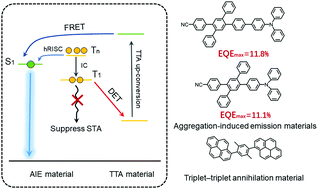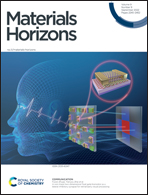Suppressing singlet–triplet annihilation processes to achieve highly efficient deep-blue AIE-based OLEDs†
Abstract
Aggregation-induced emission (AIE) materials are attractive for the fabrication of high efficiency organic light-emitting diodes (OLEDs) by harnessing “hot excitons” from the high-lying triplet exciton states (Tn, n ≥ 2) and high photoluminescence (PL) quantum efficiency in solid films. However, the electroluminescence (EL) efficiency of most AIE-based OLEDs does not meet our expectation due to some unrevealed exciton loss processes. Herein, we further enhance the efficiency of blue AIE-based OLEDs, and find experimentally and theoretically that the serious exciton loss is caused by the quenching of radiative singlet excitons and long-lived triplet excitons [singlet–triplet annihilation (STA)]. In order to suppress the STA process, 1-(2,5-dimethyl-4-(1-pyrenyl)phenyl)pyrene (DMPPP) with triplet-triplet annihilation up-conversion was doped in two AIE emitters to reduce the triplet excitons on the lowest triplet excited state (T1) of AIE molecules. It can be seen that the external quantum efficiency (EQE) of the resulting blue OLEDs was enhanced to 11.8% with CIE coordinates of (0.15, 0.07) and a negligible efficiency roll-off, realizing the efficiency breakthrough of deep-blue AIE-based OLEDs. This work establishes a physical insight in revealing the exciton loss processes and the fabrication of high-performance AIE-based OLEDs.



 Please wait while we load your content...
Please wait while we load your content...